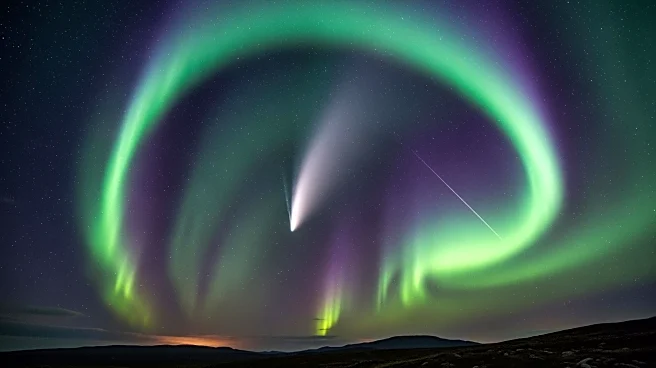What's Happening?
Comet Lemmon was photographed flying through vibrant auroras over Scotland, coinciding with a surprise geomagnetic storm caused by a coronal mass ejection from the sun. The auroras, visible in up to 15
U.S. states, displayed a range of colors including greens, reds, oranges, and pinks. Comet Lemmon, discovered in January 2025, is a nonperiodic comet that orbits the sun every 1,350 years. It is currently making its closest approach to Earth, coming within 56 million miles. The comet has brightened significantly due to its proximity to the sun, making it visible to the naked eye.
Why It's Important?
The simultaneous occurrence of Comet Lemmon's approach and the auroral display provides a unique opportunity for both scientific study and public engagement with astronomy. The event highlights the interconnectedness of solar activity and celestial phenomena, offering insights into the effects of solar storms on Earth's magnetic field. For the public, such events can enhance interest in space science and encourage participation in stargazing activities. The visibility of the auroras across multiple states also emphasizes the importance of monitoring space weather and its potential impacts on communication and navigation systems.
What's Next?
Comet Lemmon will continue to be visible in the Northern Hemisphere, with optimal viewing conditions shortly after sunset. As it approaches its perihelion on November 8, astronomers will have the opportunity to study its composition and behavior in greater detail. The auroral activity may prompt further research into the effects of solar storms and the potential for future auroral displays. Observatories and science centers may offer special viewing events to capitalize on public interest and provide educational opportunities.
Beyond the Headlines
The event underscores the importance of international collaboration in monitoring and predicting space weather phenomena. It also highlights the need for public awareness about the potential impacts of geomagnetic storms on technology and infrastructure. The vibrant auroras serve as a reminder of the beauty and complexity of natural phenomena, encouraging efforts to preserve dark sky areas for future generations.














